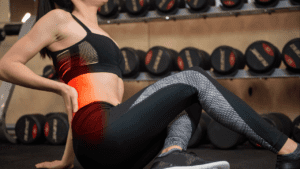Flexibility and mobility are two words we hear a lot in the fitness world. While they’re often used interchangeably, they’re very different things, and they impact our functional fitness in different ways.
So, what gives? What separates flexibility and mobility? And how does each contribute to how we feel and perform each day?
This blog will break down the differences between flexibility and mobility, how you obtain each, and how both affect our daily lives.
Flexibility 101
Put simply, flexibility is the range of motion you can achieve passively. “Passively” means you’re not moving weight, and you’re not controlling it. Think of how a chiropractor might have you lie on your back while they push your leg up the furthest it can go – that’s a great example of flexibility.
In addition to helping you ace that yoga class, flexibility is an essential part of your complete physical fitness, and good flexibility has many positive effects on the body.
For example, flexible people have improved mobility (more on this in a minute), better posture, better muscle coordination, and a reduced risk for injuries and muscle soreness. People who are flexible also experience fewer aches and pains and enjoy the ability to perform better physically, since their muscles function more effectively.
All of that sounds pretty good, right? The question, now, is how to become more flexible.
For most people, improving flexibility is as simple as doing a few simple exercises per week. Traditional yoga poses like downward-facing dog, triangle pose, and side-angle stretches are all great options, as are spinal twists and many of the activities you’ll find in any standard yoga or Pilates class.
As you work to enhance your flexibility, keep this critical tip in mind: you can’t force your muscles to be flexible all at once. Instead, take it slow and listen to your body. Back out of a pose or activity if you feel pain or discomfort. By gradually increasing your flexibility, you can stretch your muscles responsibly and avoid injury.
Mobility 101
While flexibility is the range of motion you can achieve passively, mobility is the range of motion you can achieve actively. Active motion, of course, is the motion you’re actively controlling. You get mobility by combining flexibility and stability. Mobility encompasses many things: muscle strength, range of motion, and endurance, to name a few.
Having a high level of mobility is essential for a few reasons. First, mobility allows you to move efficiently and functionally without restrictions, challenges, or pain. Mobility has also been called “The cornerstone of fitness” by the American Council on Exercise (ACE), and for a good reason. Mobility allows the body to move correctly. Without ample mobility, it’s impossible to enjoy stability in your posture or any of your movements. The result is discomfort, high injury potential, and decreased quality of life.
If you want to improve your mobility, you’ll be happy to know that it’s relatively easy to do. The first step is to identify any existing mobility problems and resolve them. Things like old injuries or health conditions like arthritis can decrease mobility, for example, and you should address your condition with your physician before you attempt to improve your functional mobility.
Visiting a skilled physical therapist is usually an excellent step. PTs have the experience and training necessary to identify the underlying cause of your decreased mobility and help you address it. You can also work with a knowledgeable personal trainer to help you avoid injury, rehabilitate old injuries, work with pre-existing physical conditions, and help you improve your mobility. Personal training benefits physical therapy by reducing the number of treatments and recovery time in a majority of instances.
You’ll focus on targeted training and exercises designed to help you increase your mobility and start moving better.
Is Flexibility or Mobility More Important?
People often ask us which is more critical: flexibility or mobility? The truth is, while flexibility can help you achieve enhanced mobility, extreme flexibility won’t necessarily help you become more functional and live a better life. Although you can’t underestimate the importance of functional flexibility, we don’t think everyone needs to achieve advanced yoga poses to be healthy and improve your quality of life.
The research backs this up. According to a review published by the Clinical Journal of Sports Medicine, static stretching doesn’t correlate with injury reduction. The bottom line: even if you can wrap your arms around your feet, it won’t help you stay fit or healthy.
Functional mobility is the thing that will help you lead a healthier, more comfortable life. Since mobility is essential for injury prevention and athletic performance, it’s generally a better indicator of injury prevention and overall strength than flexibility. Mobility is what will help you increase joint health, banish pain, and decrease the risk of injury.
Fortunately, it is possible to increase your mobility. Simple at-home efforts like foam rolling or using a lacrosse ball on sore muscles can increase myofascial release and improve mobility. Participating in mobility-specific classes is another excellent way to enhance your mobility gradually.
No matter what you choose to do, be sure to work with a pro. A professional will help you enhance mobility and flexibility safely and gradually and without getting injured.
Alloy Personal Training: Your Partner in Better Mobility
Here at Alloy, we’ve been on the mobility train for years. We know our clients need high levels of mobility to feel comfortable, pain-free and perform at their highest athletic potential.
Our trainers focus on working with each client to enhance flexibility and mobility and ensure functional fitness that improves every aspect of life.
Want to learn more about our group fitness or personal training offerings? Click here.




